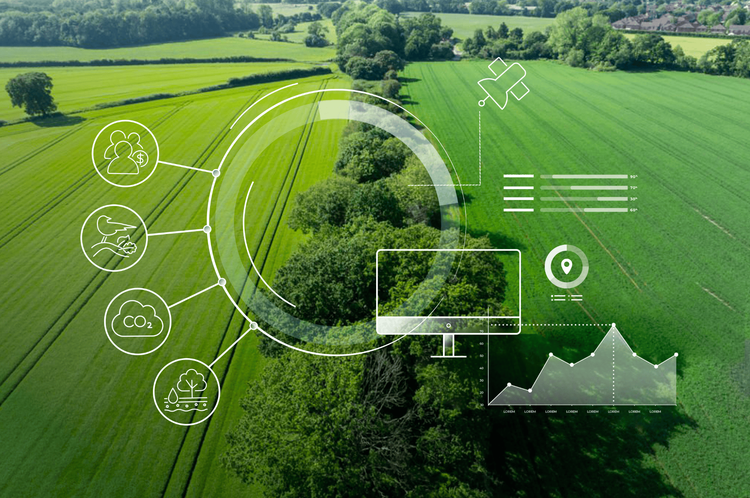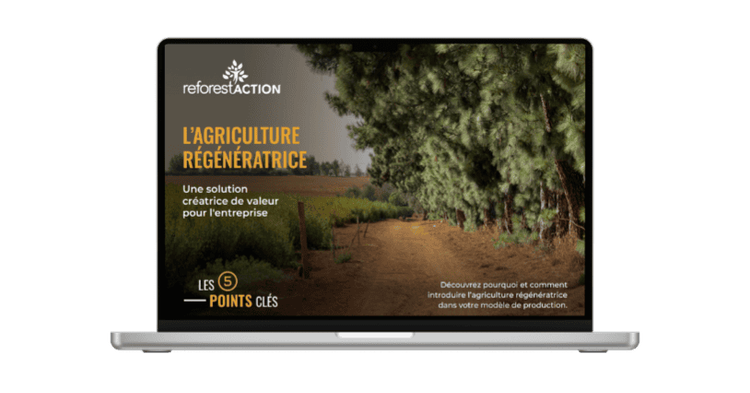Develop Regenerative Agriculture in your Value Chain
Transform your raw material production practices to secure your supply chain and achieve your CSR objectives.
Contact usWhy Transform Your Production Chain?
The risks are very real for both farmers and buyers. Natural resource shortages and extreme weather events rank among the top five most severe environmental risks of the coming decade. These are directly linked to a global economic crisis that will predominantly impact supply chains.
The adoption of regenerative agricultural practices is a recognized solution with clear and significant benefits in the short, medium, and long term.
What are the Benefits for Companies?
Regenerative agriculture presents an opportunity to address environmental challenges while creating economic and social value. By implementing these practices, companies can not only improve their resilience to climate risks but also enhance their competitiveness and ensure compliance with increasingly stringent regulatory requirements.
Regenerative agriculture helps mitigate risks associated with climate change, such as reduced agricultural yields due to soil degradation or extreme weather events, thereby stabilizing and securing raw material supplies.
Beyond a competitive advantage in brand image, regenerative practices contribute to yield stability and lower production costs. Additionally, a company's ESG performance is becoming a crucial factor in its financial valuation.
Regenerative agriculture helps reduce carbon footprints and promotes carbon sequestration in soils, meeting the growing demand for robust corporate climate strategies.
Adopting regenerative agriculture helps companies comply with current standards and prepares them for increasingly strict future regulatory requirements, particularly regarding land management.
Agroforestry: A Major Component of Regenerative Agriculture
Agroforestry refers to the integration of trees within agricultural landscapes. This land management system can take various forms and practices, all of which involve the introduction or management of trees, shrubs, and hedgerows around and/or within agricultural plots.
Benefits of Trees in Agricultural Environments:
Increased carbon storage in agricultural areas, notably through higher soil organic matter content; Creation of a microclimate around crops.
Creation of habitats for wildlife; Increased soil fauna and fungi; Return of beneficial species (such as birds that prey on pests) and pollinating insects.
Enhanced soil fertility; Restoration of soil structure; Soil stabilization through root systems; Prevention of erosion; Barrier against drying or cold winds.
Slowed runoff; Improved water infiltration into soils; Enhanced water quality; Reduced irrigation needs.
Increased yields; Additional income sources; Enhanced food security for farming communities in tropical areas.
They already trust us



Our 4-Step Approach
We conduct an on-site visit to validate the project's feasibility and establish a preliminary budget. Stakeholders are involved when necessary to ensure the project's success (e.g., neighboring landowners).
Our engineers design the project based on the context and strategic expectations. This quantitative and qualitative approach allows us to refine the budget and define the impact measurement framework.
The project is implemented on a pilot scale to validate the design in the field. This phase, carried out with local farmers, is supervised by Reforest'Action experts and includes a training/skills transfer component.
Reforest'Action measures the project's impacts over 30 years. This measurement is structured around climate, biodiversity, water, soil, and socio-economic criteria, detailed according to several indicators defined based on the project's objectives.
We Help You Value Regenerative Agriculture in the SBTi FLAG (Forest, Land, and Agriculture):
- Develop degraded land restoration projects to meet your target goals.
- Define specific practices and objectives.
- Establish methodologies and measure benefits.
- Collaborate with stakeholders to encourage the adoption of these practices.

Impact Measurement at the Heart of Our Approach
We consider impact measurement essential and central to our approach:
- We support you in measuring the impact of a project over a period of up to 30 years.
- Internal protocols and impact measurement indicators are developed.
- We ensure that indicators are recognized by international frameworks and renowned peers.
- An MRV platform is internally designed to monitor your projects.
- Measurement should not exceed the project cost; we implement a hybrid impact measurement approach, combining remote and on-site monitoring.

A Collaborative Approach
To ensure the relevance of our research and innovation efforts, our dedicated team collaborates with renowned institutions and companies with expertise in cutting-edge technology (such as The Global Biodiversity Standard and Kanop, among others).




Reforest'Action, 15 years of experience in agroforestry
Download our white paper about regenerative agriculture
Divided into five chapters, this white paper offers you a comprehensive understanding of the need to begin your agroecological transition in order to guarantee the sustainability of your activities and create value for your company.
Discover why and how to implement a regenerative agriculture project that will enable you to achieve your SBTi FLAG objectives.

Want to go further?
Are you a company considering the development of your value chain? Our experts are here to discuss your needs and support you in your planning process.
FAQ
Discover our articles about Regenerative Agriculture :
29/01/2025
04 min
Modeling the impact of agro/forestry projects on the soil-water system
Lire l'article27/02/2024
12 min
Core elements of designing a regenerative agriculture project
Lire l'article14/07/2023
08 min